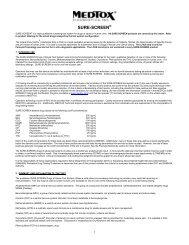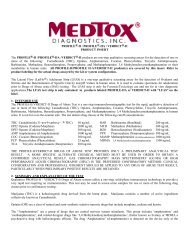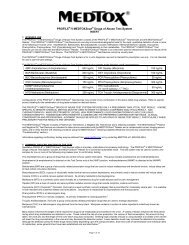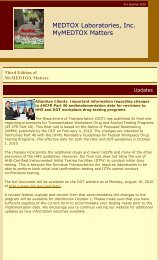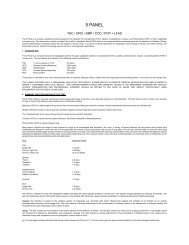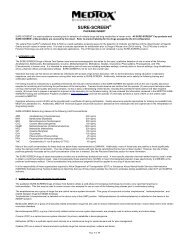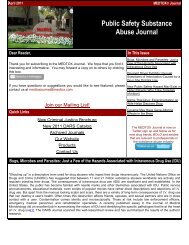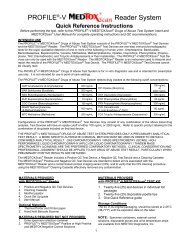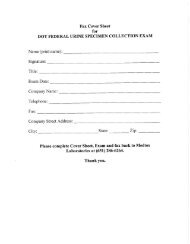92 Frequently Asked Questions on the New 510(K) Paradigm - Medtox
92 Frequently Asked Questions on the New 510(K) Paradigm - Medtox
92 Frequently Asked Questions on the New 510(K) Paradigm - Medtox
You also want an ePaper? Increase the reach of your titles
YUMPU automatically turns print PDFs into web optimized ePapers that Google loves.
4. MATERIALS PROVIDED/STORAGE CONDITIONSEach SURE-SCREEN Drugs of Abuse Test c<strong>on</strong>tains all <strong>the</strong> reagents necessary to test <strong>on</strong>e urine sample for <strong>on</strong>e or more drugs simultaneously. SURE-SCREEN testdevices are available in Cup or Dip format as described below.Kit C<strong>on</strong>tents – Cup Test formatThe SURE-SCREEN Drugs of Abuse Cup Test kit c<strong>on</strong>tains twenty-five (25) test system bags and <strong>on</strong>e reference guide.Each Cup Test system bag c<strong>on</strong>tains:1. One (1) test device in a foil package.1. Each test device has test strips with drug specific reagents.2. The test device may c<strong>on</strong>tain a membrane strip laminated with Adulterant test pads for testing <strong>the</strong> presence of Oxidants and Nitrites, as well asdetermining approximate values of Specific Gravity and pH in human urine. (Products with LFAS test strip <strong>on</strong>ly; <strong>the</strong> LFAS test strip is notc<strong>on</strong>tained in every SURE-SCREEN product.)2. One (1) cup with temperature strip attached.3. One (1) lid.4. One (1) security seal.5. One (1) Color Comparator Chart (products with LFAS test strip <strong>on</strong>ly).Kit C<strong>on</strong>tents – Dip Test formatThe SURE-SCREEN Drugs of Abuse Dip Test Kit c<strong>on</strong>tains twenty-five (25) test devices in foil packages and <strong>on</strong>e reference guide.Each Dip Test device has test strips with drug specific reagents.Materials Required but not providedTimerA urine collecti<strong>on</strong> c<strong>on</strong>tainer is not provided with <strong>the</strong> Dip device.Specimen c<strong>on</strong>tainers, disposable gloves and urine temperature strips are available from MEDTOX Diagnostics, Inc.Storage C<strong>on</strong>diti<strong>on</strong>sThe kit, in its original packaging, should be stored at 2-25°C (36-77°F) until <strong>the</strong> expirati<strong>on</strong> date <strong>on</strong> <strong>the</strong> label.5. PRECAUTIONS1. Urine specimens and all materials coming in c<strong>on</strong>tact with <strong>the</strong>m should be handled and disposed of as if infectious and capable of transmitting infecti<strong>on</strong>. Avoidc<strong>on</strong>tact with broken skin.2. Avoid cross-c<strong>on</strong>taminati<strong>on</strong> of urine samples by using a new urine specimen c<strong>on</strong>tainer for each urine sample.3. The device should remain in its original sealed foil pouch until ready to use. If <strong>the</strong> pouch is damaged, do not use <strong>the</strong> test.4. Do not store <strong>the</strong> test kit at temperatures above 25°C (77°F).5. If devices have been stored refrigerated, bring to ambient temperature (18-25°C/ 64-77°F) prior to opening foil pouch.6. Do not use tests after <strong>the</strong> expirati<strong>on</strong> date printed <strong>on</strong> <strong>the</strong> package label.7. The drug screen and <strong>the</strong> LFAS strip are for Forensic/Toxicology use <strong>on</strong>ly.6. SAMPLE COLLECTION AND PREPARATIONFor a Cup Test, collect <strong>the</strong> urine sample in <strong>the</strong> provided cup. The urine volume should be between <strong>the</strong> minimum and maximum volume lines.For a Dip Test, collect <strong>the</strong> urine sample in a clean specimen c<strong>on</strong>tainer.Collecti<strong>on</strong> of 45 mL of urine is more than sufficient for testing. No preservatives should be added. Urine may be tested immediately following collecti<strong>on</strong>. If it isnecessary to store <strong>the</strong> urine, store under refrigerati<strong>on</strong> at 2 to 8°C (36 to 46°F) for no more than two days. Urine may be frozen at -20°C (-4°F) or colder for storage.Stored urine must be brought to ambient temperature (18 to 25°C/64 to 77°F) and mixed well to assure a homogeneous sample prior to testing.7. TEST PROCEDURECup Test1. Bring pouched device to room temperature before opening it. Fill urine sample cup between <strong>the</strong> minimum and maximum volume lines.2. Screw lid clockwise <strong>on</strong>to <strong>the</strong> cup until very tight.3. Open pouch and label <strong>the</strong> device with <strong>the</strong> patient or sample identificati<strong>on</strong>.4. C<strong>on</strong>nect device to lid securely as follows: Hold cup with raised sample port toward you. Hold device cassette with MEDTOX labeled end to your left.Place device cassette <strong>on</strong> top of cup lid with holes aligned. Rotate <strong>the</strong> device clockwise ¼ turn until it snaps in place.5. Tip <strong>the</strong> cup <strong>on</strong> its side to start flow (if less than 45 ml of urine, tilt <strong>the</strong> cup forward to begin flow).6. If LFAS is present, read pH, Specific Gravity, and Nitrites in vertical positi<strong>on</strong> as so<strong>on</strong> as color changes. Read oxidant at 60 sec<strong>on</strong>ds.7. Allow <strong>the</strong> test cup to sit <strong>on</strong> its side for 5 minutes.8. Turn <strong>the</strong> test cup upright and read <strong>the</strong> results. C<strong>on</strong>trol line must be present to read results. Negative results can be read as so<strong>on</strong> as a test line is visible,n<strong>on</strong>-negatives at 5 minutes.Dip Test1. Bring pouched device to room temperature before opening it.2. Open <strong>on</strong>e pouch for each sample to be tested. Write patient or sample identificati<strong>on</strong> informati<strong>on</strong> <strong>on</strong> <strong>the</strong> device.3. Pull off <strong>the</strong> clear cover to expose <strong>the</strong> fiber pads at ends of test strips.4. Dip <strong>the</strong> small end of <strong>the</strong> cassette into <strong>the</strong> sample so that <strong>on</strong>ly <strong>the</strong> white ends of <strong>the</strong> test strips are submerged.5. Hold <strong>the</strong> ends of <strong>the</strong> test strips in <strong>the</strong> sample until <strong>the</strong> reddish-purple soluti<strong>on</strong> begins to run up all of <strong>the</strong> strips.6. Remove <strong>the</strong> device from sample and replace <strong>the</strong> cover to protect <strong>the</strong> wet ends of <strong>the</strong> test strips.7. Lay cassette flat, face up for 5 minutes.8. Read <strong>the</strong> results. C<strong>on</strong>trol line must be present to read results. Negative results can be read as so<strong>on</strong> as a test line is visible, n<strong>on</strong>-negative at 5 minutes.NOTE: Read results at 5 minutes or within 15 minutes of <strong>the</strong> sample applicati<strong>on</strong>. Oxycod<strong>on</strong>e should be read at 5 minutes. Test results interpreted after 15minutes (for Oxycod<strong>on</strong>e after 5 minutes) may not be c<strong>on</strong>sistent with <strong>the</strong> original results obtained at 5 minutes.8. READING THE TEST RESULTSNegative:N<strong>on</strong>-Negative:Invalid:The appearance of a reddish purple line at both <strong>the</strong> c<strong>on</strong>trol area (C) and appropriate test area (T) indicates a negative test result. The colorintensities of <strong>the</strong> c<strong>on</strong>trol lines (C) and test lines (T) may not be equal and may vary from test to test. The test line and c<strong>on</strong>trol line positi<strong>on</strong>smay vary slightly from test strip to test strip. Any line of reddish-purple color, even of faint intensity, indicates a negative test result.The appearance of a c<strong>on</strong>trol line and <strong>the</strong> absence of a test line indicate a preliminary positive test result for that drug.The c<strong>on</strong>trol line must be present for <strong>the</strong> test to be valid. The absence of a c<strong>on</strong>trol line indicates <strong>the</strong> test is invalid. The urine sample shouldbe retested <strong>on</strong> a new device.Page 3 of 11



